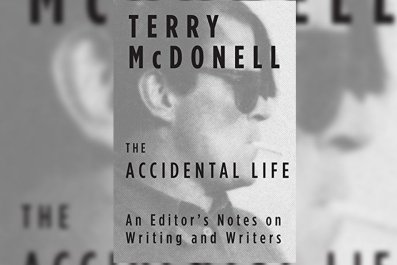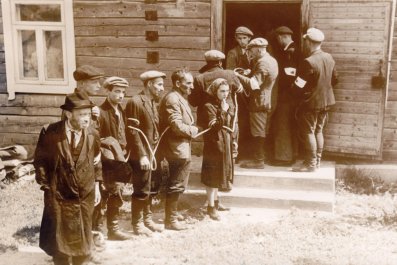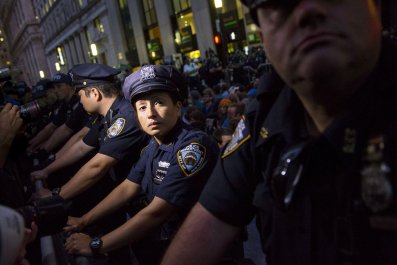A weird thing happens to kids around kindergarten. Ask a 5-year-old about his visit to the aquarium a year prior, and there's a good chance he'll tell you all sorts of details: the color of the reef, what was in the touch tank. But ask him about the same trip when he's 7, and it's likely he won't remember a thing.
That's backed up by research: In one major study, Emory University psychologist Patricia Bauer and a colleague invited a bunch of 3-year-olds into her lab and interviewed the children about events in the previous three months, like trips to the zoo or birthday parties. The researchers then brought back some of the children two years later and again six years later. Both times, they asked the kids to recall events they described as 3-year-olds. They found that the children remembered about 60 percent of the events during their second interview (when they were about 5) but much, much less in the third (when they were around 8)—a deterioration of memory greater than usual. "Something was happening at age 7," says Bauer.
People have been aware of this sort of childhood amnesia at least since Sigmund Freud coined the phrase at the turn of the 20th century, but it's only recently that advanced imaging has been combined with long-term behavioral studies to allow scientists to start to really understand how childhood memory fundamentally differs from the adult version. As kids' brains develop and add connections, they lose more memories than they create—and at the same time, early memories tend to be partial and therefore more likely to erode.
Paul Frankland, a researcher at the Hospital for Sick Children in Toronto, knew that in order for a memory to be planted in our brains for good, it first needs to get stored in the hippocampus—which connects related simultaneous memories from different sensory regions of the brain, forming them into a single episode. Frankland and his lab collaborators wanted to find out how new neuron production in the brain—neurogenesis—affects memories already stored in the hippocampus. To do that, they gave animals drugs that made their brains create new neurons, then tested their ability to remember a bit of training. The researchers found that the animals forgot the experience quickly: Neurogenesis caused rats to lose memories faster. Frankland explains it this way: If a system suddenly adds a bunch of new connections and complexity, the entire setup may go sideways for a while until things are sorted out.
This work led Frankland to look at infancy, when neurogenesis happens at much higher rates than adulthood (a human infant's brain generates 2,100 to 2,800 new neurons each day compared with about 700 for adults). Frankland and his colleagues trained baby and adult animals in memory tasks, like learning to fear an area where they received small shocks, and tested them a few weeks later. As expected, the baby animals lost the memories. But when they were given drugs that reduced the new connections in the brain, the baby animals retained the memories at a much higher rate. "We're convinced that neurogenesis is one of the major factors that leads to forgetting in both adults and infants," says Frankland. And the fact that it happens at such high rates in small children might explain why so many of their memories seem to disappear.
Frankland has worked on neurogenesis for the past five years, and he's also watched his daughter age from 2 to 7. Early on, they took a trip to the zoo, where the toddler had a traumatic experience: A goose ran at the little girl, scaring her. Afterward, Frankland and his wife quizzed her on the adventure every couple of months, and every time, she'd tell the same story about the scary bird—until one day the memory was gone. As he researched infantile amnesia, he was also watching it happen: "It just underscores the idea that as the brain develops, the ability to make memories of episodes of events develops," says Frankland. "But after a certain stage, it's the ability to keep the memory around that's the problem."
Bauer says that while age 7 isn't a magic cutoff, two complementary processes happen then that make it an interesting turning point. While memories are being formed throughout development, from about 3 to 7, more memories slip away than get fixed into long-term storage, resulting in a net loss.
Second, the quality of memories improves around age 7 because the brain is closer structurally to an adult brain, which makes memories created after that age more likely to be accessible. Think of these early memories as partial fragments: a young child may remember who but not what, when, where or why. Getting all those pieces together makes a memory more likely to be sticky.
The things that tend to stick around have a clear pattern. When Carole Peterson was starting out as a researcher at Memorial University of Newfoundland in St. John's, in the 1980s, she had read studies showing children's memories in preschool weren't very good, but she didn't believe it. "I thought they weren't asking children about the right events," she says, explaining that most studies tried to get children to recall ordinary, everyday events like last weekend at Grandma's. Peterson believed it made more sense to test memories of highly emotional events, because those, she thought, were more likely to be remembered.
She set off to do a series of unusual experiments, sending graduate students to camp in the waiting room of the emergency room at the Janeway Children's Health and Rehabilitation Centre in St. John's. There, they recruited young kids with injuries for interviews after their hospital release. The idea was to test how accurately they remembered the emergency that landed them in the hospital—and compare the differences in the precision of those memories at various ages, from 2 to 13. Peterson and her students also interviewed adult eyewitnesses for each event for some baseline details. Later, the researchers brought those kids back—some six to 12 months later, and others five or 10 years later—to ask about the same events.
"We were staggered by the accuracy," recalls Peterson. During the first interview, the 5-year-old kids had an accuracy level at 97 percent compared with the description of the event by adult eyewitnesses; five years later, it was 91 percent. Even 10 years later, they had remarkable recall: Accuracy dropped to a still quite high 85 percent. What's more, as the years went by, the kids began fleshing out the memories with novel—and 100 percent correct—pieces of additional data. "If the first time they were interviewed, the child said, 'The event happened at my nan's, then years later, they would say that 'it happened at my nan's down by the hole in the fence,'" says Peterson.
The point is that while children are not great at storing the mundane—Peterson pointed out that kids' memories of being in the hospital were pretty dim—they have a fantastic memory for emotionally salient events.
It's unclear whether all those other early memory fragments are completely gone or just inaccessible. It's a question that Massachusetts Institute of Technology researcher Susumu Tonegawa and colleagues are trying to answer, using lab mice genetically engineered so that their memory-forming brain cells are sensitive to light. In a recent project, the mice first received a small shock on their feet while exploring a box. Immediately, that traumatic memory was encoded into those cells, which were tagged with a special light-sensitive protein. Tonegawa used a technique called optogenetics in which a laser sends blue light pulses to selectively turn on or off the brain cells. When the laser stimulated the brain cells, the mouse froze in fear of the shock, despite not experiencing any pain.
Scientists made mice depressed by wrapping them in plastic wrap for 40 minutes a day over a period of 10 days—making the mice so stressed they didn't even enjoy their usually beloved sugar water—then they were able to reverse the symptoms by artificially activating happy memories formed before the onset of depression. The researchers say the work has implications for potential treatments for depression, post-traumatic stress disorder and Alzheimer's disease.
While the technology is promising, it's controversial and has yet to be tested in humans. And there are simpler ways to get kids to keep early memories accessible, without breaking a leg or using light in the brain: talking with them. Researchers have shown that kids of parents who talk in elaborative ways—asking open-ended questions, encouraging follow-ups and adding new information when talking through a memory—actually retain more memories and have earlier memories than kids whose parents don't talk in this way. By reminiscing together, parents and kids can weave the threads of memory pieces into a sturdy cloth, which could help kids to understand their pasts—and improve their futures.

















